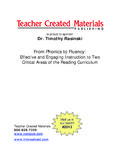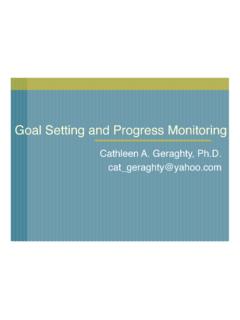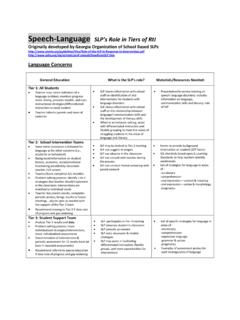Transcription of PROGRESS M
1 PROGRESS MONITORING STUDY GROUP CONTENT MODULE DEVELOPED BY STANLEY DENO, ERICA LEMBKE, AND AMY RESCHLY ANDERSON STUDY GROUP, CONTENT MODULE 2 Section 1: Background Introduction The purpose of this module is to provide participants with an introduction to procedures for monitoring student reading PROGRESS in the classroom based on Curriculum Based Measurement (CBM), and the steps required to implement a system for screening and monitoring students in the area of reading and summary of research on the effectiveness of these procedures.
2 Throughout this module the focus is on students who are not making satisfactory PROGRESS and are at risk of failing to develop basic reading skills. This module is organized into fifteen sections. In addition, a study guide has been developed that complements the information and procedures outlined in this module. 1 Background CBM was developed by Stanley Deno, Phyllis Mirkin, and others at the University of Minnesota. The roots of CBM are in the Data-Based Program Modification (DBPM) model created by Deno and Mirkin in the late 1970 s. The purpose of this model was to describe how frequent data collection could be used to make educational programming decisions for students in special education.
3 This model and subsequent research program were further developed and investigated as part of the University of Minnesota Institute for Research on Learning Disabilities. The goal of this research was to determine if the use of a formative evaluation system like DBPM would improve teachers effectiveness in teaching students with learning disabilities and therefore, also improve students performance (Deno, in press). In order to develop this formative evaluation, or PROGRESS monitoring system, researchers at the IRLD aimed to a) create a set of generic procedures for measuring student PROGRESS in the core educational skills of reading, spelling, and written expression, and b) establish the reliability and validity of these measurement procedures.
4 In the last twenty years, these measurement procedures have been used by general and special educators across the United States. 1**THE PHRASES PROGRESS MONITORING AND CBM ARE USED SYNONYMOUSLY THROUGHOUT THIS MODULE AND SHOULD BE INTERPRETED AS THE SET OF PROCEUDRES UTILIZED TO MONITOR STUDENT GROWTH IN READING What is CBM? CBM is an approach to measuring the growth of student proficiency in the core educational skills that contribute to success in school. It is a fast, inexpensive, and easy-to-use system that allows teachers to continuously measure their students growth in performance, determine if their students are growing at the expected rate, and provide data for teachers to evaluate their instructional strategies if students are not demonstrating adequate growth.
5 What is measured? In reading, students accuracy and fluency when reading aloud from text are assessed. STUDY GROUP, CONTENT MODULE 3 What is the purpose? To provide educators with an efficient way to evaluate the effectiveness of a student s instructional program. What are the characteristics of the measures? Frequent sampling of performance ( , weekly, quarterly, etc.) Graphing of PROGRESS What are the ordinary uses of this system? Collecting direct, frequent measures of student PROGRESS Establishing individualized instructional goals Using data to make instructional change decisions Why use this system?
6 Twenty years of research establishes that: These measures reliably and validly describe student growth When data regarding a student s PROGRESS are used to make instructional decisions, his/her performance is greatly improved Advantages of this approach: CBM has several advantages over traditional norm-referenced assessment and other informal measures of student performance in that it is: Based on typically used curriculum most often that used by the school or district Individually referenced (an individual s performance is compared to his/her own performance over time) Peer referenced (a student s performance is compared to their same-grade peers)
7 A tool that can provide teachers with information to make instructional change decisions A method that allows for direct and continuous monitoring of student achievement related to expected curriculum outcomes Highly sensitive to student growth, detecting even small changes in student performance. Time efficient (passages require only one-minute to administer) Cost effective (elaborate materials are not needed); and A method that produces results that are easier to understand than normative tests using standard scores STUDY GROUP, CONTENT MODULE 4 Section 2: Screening An increasingly common use of CBM is to screen students who are at-risk for academic failure (Deno et al.)
8 , 2002). Given that CBM procedures are standardized, they can be used to contrast an individual s performance to that of a group. The use of local norms is common for this purpose, but norms are not required. We have provided criteria that may be used as grade-level benchmarks in Section 8. CBM can be easily and quickly used to assess the performance of a group of students and to identify the lowest achieving, at-risk students in the group (Marston & Magnusson, 1988; Shinn, 1995). Performance goals are set for these students and their PROGRESS toward these goals is monitored frequently.
9 If students are not reaching their goals, instruction should be modified to accelerate student PROGRESS . Periodic screening of all students is also recommended. In the same way that teachers set goals for the performance of individual students, it is also helpful to consider and set goals for the performance of an entire class or grade. The typical steps and procedures used in developing a PROGRESS monitoring system are as follows: Steps: 1. Classrooms/grades or grades to participate are identified Usually determined by classroom teachers or teams 2.
10 Skill/curriculum area are identified , Reading 3. Measures are created Oral Reading or maze 4. Students are screened Students are screened in the Fall 5. Students are ranked and/or school norms are created Rank students by grade/classroom* 6. Lower-achieving students are identified , Bottom 40% of students in each grade/classroom are selected* 7. Goals are set Typically, year-end goals are set for individual students 8. Low achievers are frequently monitored (graph) Graphing oral reading performance might occur once per week 9. PROGRESS is regularly evaluated Data are evaluated using a systematic set of decision rules 10.



